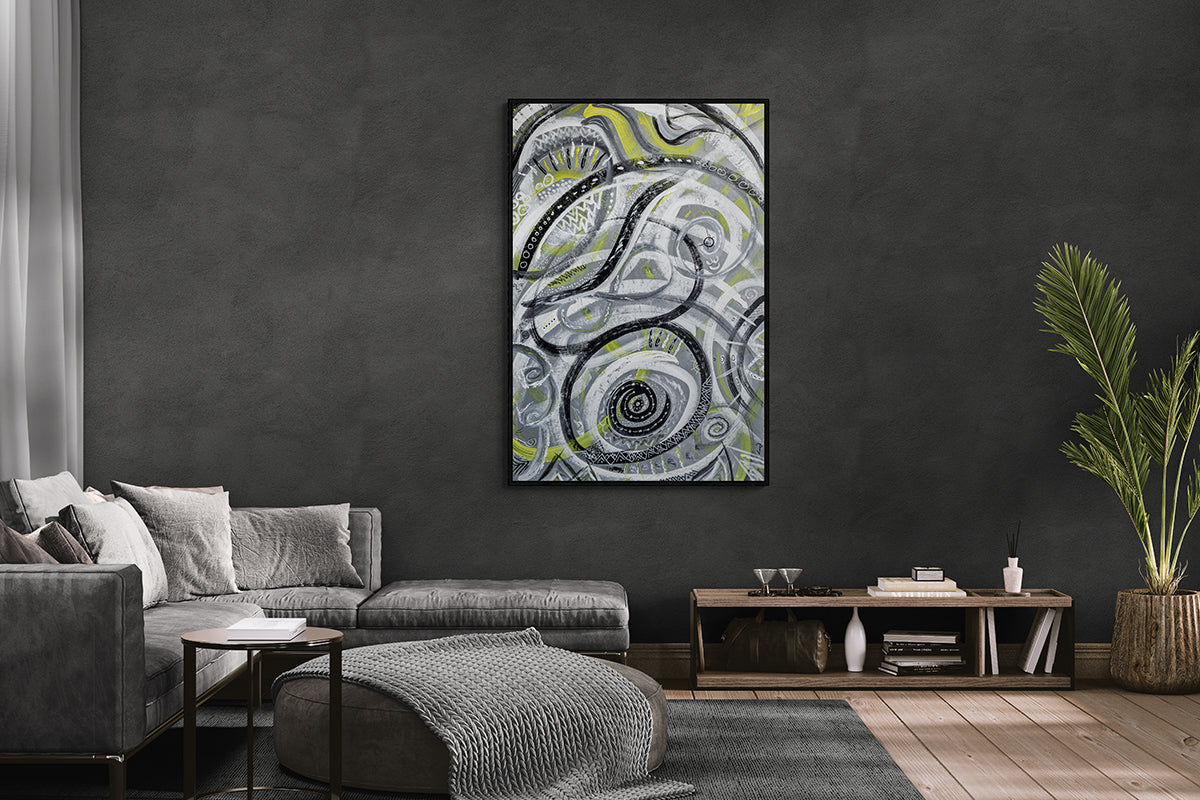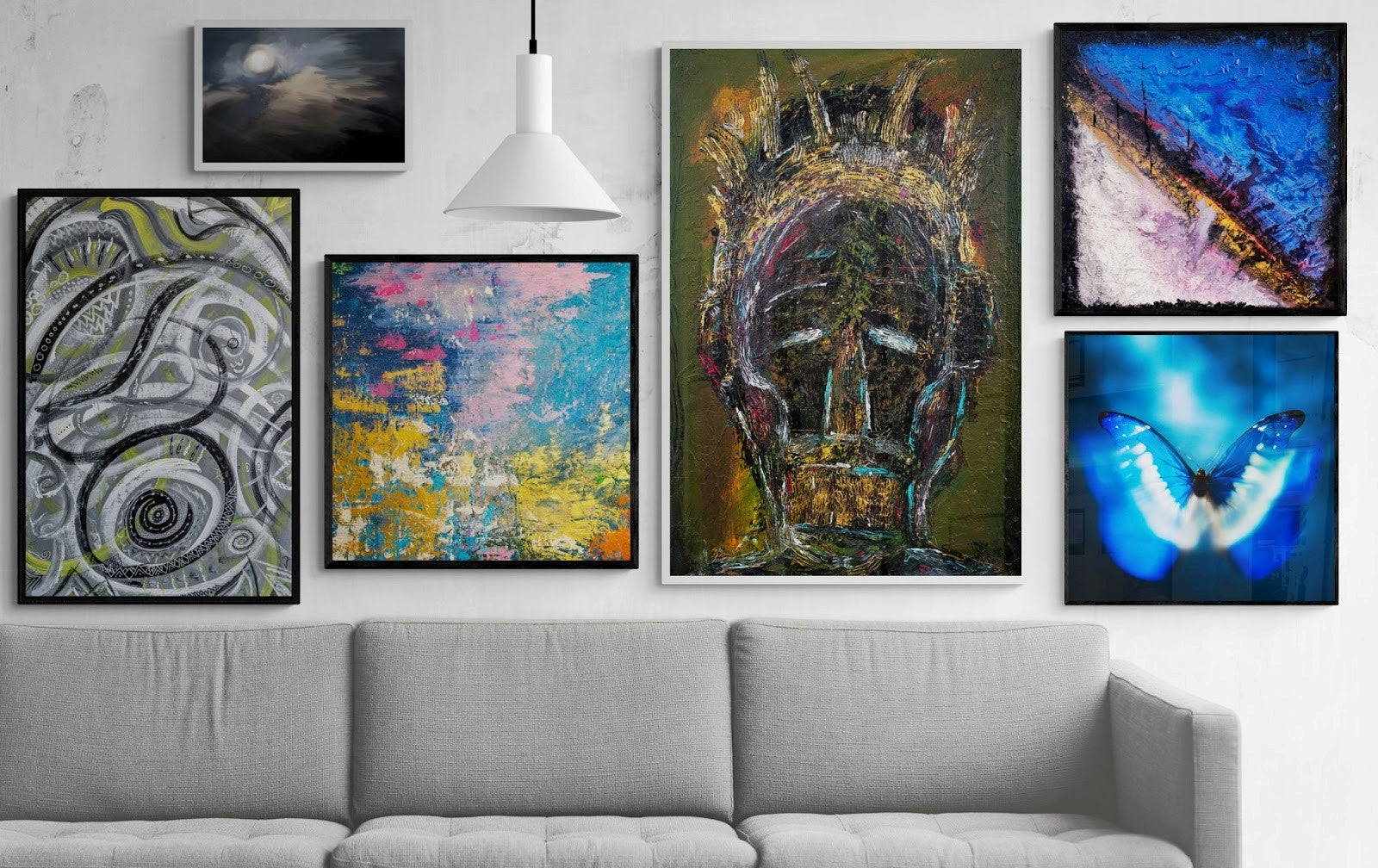Lighting can change everything when it comes to how wall art is experienced. It shapes the mood, brings out details people might otherwise miss, and adds a layer of depth that can make an entire space feel more thoughtful. Whether you're decorating a quiet corner of your home or filling up an open wall at work, the way light interacts with your art can influence how it's viewed, felt, and remembered.
Shadows are just as powerful. They create contrast, amplify emotion, and give a sense of movement or calm depending on where and how they're cast. If you're choosing art for the office or picking out a new piece for home, understanding how light and shadow work together can help you make smart display choices that make the piece really stand out. Let’s take a look at how light and shadow shape visual art and how you can use that to your advantage.
The Role Of Light In Art Displays
Light is more than just brightness. It can highlight colors, make textures pop, and even shift how a piece of art feels throughout the day. The right lighting sets the tone without calling attention to itself, and learning how different types of light affect your space can make a big difference.
Start with understanding the two main types of light:
1. Natural light: Sunlight brings warmth, creates soft shadows, and can give artwork a more dynamic look from hour to hour. But too much direct sunlight over time can damage or fade delicate pieces, especially works on paper or canvas. So it’s best used in rooms where you can manage the exposure with shades or curtains.
2. Artificial light: This gives you more control. You can adjust the intensity, direction, and color temperature (warm, cool, or neutral). It lets you keep your artwork looking consistent, no matter the time of day or weather outside. LED lights are often a solid pick since they don’t give off much heat and won’t damage delicate materials.
Different light sources also affect how colors seem. A deep blue under warm light might look muted or slightly green. A bold red might appear even stronger under cool light. That’s why it's useful to view a piece under the type of lighting you plan to display it in, especially when selecting art for the office, where lighting conditions can be far different from those at home.
Here are some quick tips for positioning your art with the best lighting:
- Avoid placing art directly across from windows to reduce glare
- Use directional lighting, like track or picture lights, to focus light on the piece, not the wall
- If you're lighting multiple pieces, make sure they all share a consistent color temperature to avoid a mismatched look
- Angle fixtures between 30 to 45 degrees to reduce unwanted shadows and avoid damaging reflections
Lighting isn’t just about visibility. It’s about how a piece connects with its environment. With the right setup, even a small fine art print can feel impactful, especially in professional spaces where first impressions matter.
Exploring Shadow Effects In Art Displays
While lighting often gets the spotlight, shadows deserve a closer look too. When used thoughtfully, shadows can help a flat work of art feel dimensional. They add interest around the edges, guide the eye across the space, and can shift the way a viewer interacts with the piece just by changing position slightly.
Shadow play works best when it feels intentional. Too much shadow can hide details, but a subtle shadow cast by a light source just off to the side can give your wall art a new sense of movement. It’s like having an extra layer that isn’t part of the actual art but still changes the way it’s seen. And when choosing art for the office, having that added depth can make a standard hallway or reception area feel far more personal and elevated.
Here’s how to make the most of shadow effects:
- Pick a directional light like a spotlight or adjustable lamp. These help create controlled shadows that highlight edges instead of washing the art out
- Try backlighting in small doses. A soft glow from behind the frame can outline the piece without overwhelming it
- Use wall paint color to your benefit. A darker wall will make shadows crisper and more visible, while lighter walls diffuse them and make the effect softer
One example: A black-and-white abstract piece hung in a softly lit office hallway with an overhead spotlight creates gentle shadows that highlight the brush textures. Those shadows change throughout the day as lighting shifts, giving the artwork a sense of constant movement even though it’s standing still.
Shadows give artwork context within a space. They connect what’s on the wall with what’s around it. When you know how to use them well, you can turn a simple art display into something far more interesting and dimensional.
Combining Light And Shadow For Optimal Impact
Light and shadow work best when they’re handled together. When balanced well, they can shift the feeling of a room, call attention to techniques in a piece, and even make small works feel larger than life. The goal isn’t just to brighten a painting or cast a shadow. It's to let the art interact with the surrounding space in a way that makes people pause.
An uneven setup will take away from what the piece is trying to express. Light it too heavily and it flattens the work. Cast too much shadow and you lose detail. But when you get the balance right, the result feels grounded. The artwork becomes part of its environment rather than something that just hangs on a wall.
A few situations where light and shadow work especially well together:
- Mixed media artwork, where different layers or textures benefit from changing contrast
- Art with metallic or glossy elements, which reflect light and throw shadows uniquely
- Large abstract pieces that gain more presence with side lighting and angled shadows
If you're hanging art for the office, steer clear of overly harsh overhead lighting. Fluorescents can wash out color and spoil depth. Stick with a mix of ambient lighting and directional fixtures aimed at your art pieces from the front or side. Add dimmers if possible so you can adjust throughout the day.
A quick list of tips for keeping your space balanced:
- Test lighting at different times during the day to see how it shifts
- Use consistent bulb temperatures to avoid clashes in tone
- Don’t light art from directly below. It creates unnatural upward shadows
- Stay away from bulbs that produce lots of heat, especially around delicate works
- Position seating or desks in a way that allows people to view the art without creating blocking shadows
The adjustments don’t have to be huge. Even a slight tilt in a fixture or small change in position can make the image feel warmer, cooler, or more three-dimensional. It’s like staging the artwork so it always performs well.
Adapting Light And Shadow For Different Art Styles
Different styles of art need different lighting setups. What brings out the best in a minimalist piece might dull the detail work in a more complex mixed media collage. If you're collecting across styles such as abstract, photographic, or digital, spend some time tailoring how each piece gets shown.
For example, pieces with darker tones or high saturation may need a slightly brighter light to reveal their layers. Meanwhile, lighter, subtle works might benefit from softer, diffused light that doesn’t overwhelm them. If you're working with neutral office walls, adjusting lighting angle and brightness can give even grayscale pieces more dimension.
To make art more interactive and engaging with your space, here are a few ideas to experiment with:
- Try rotating light sources to cast new shadow patterns each week
- Add layered lighting. Use both ceiling fixtures and lower-level table lights to create movement
- Install a picture light with an adjustable arm to shift lighting as needed
- Consider placing mirrors or reflective surfaces nearby that bounce light back toward the artwork
- Mount a dim LED strip around the frame that gives off a soft, controlled halo effect
Joe Papagoda’s artwork is a good example of how these flexible setups work well. His original art pieces often utilize contrast, texture, and layered detail. When lit with a side angle spotlight, the brushwork lifts slightly off the canvas, and shadows fill spaces between shapes, adding subtle depth. It’s a quiet change but one that makes the art feel more alive.
The key is understanding what each piece needs, and that only comes from seeing how the lighting and shadow work in real time. There's no perfect formula. But with some small changes, you can bring out more feeling, a stronger focus point, or even a quiet rhythm inside the space where you place the art.
Illuminate Your Office Art Display
The impact of light and shadow on wall art isn’t just something to think about once the piece is on the wall. It shapes how it's perceived every day. From the way natural light filters through a window in the morning to how an overhead fixture spreads out at night, those changes all affect the mood a piece sets for the room.
When you're selecting art for the office, it's easy to focus on the visuals alone - color, subject, style. But the lighting conditions and how shadows fall around the piece matter just as much. They round out the story the art is telling and help create a layered experience for anyone passing by or spending time near it. Whether you're decorating a private office or a shared lounge, the environment the art lives in will either elevate or flatten its presence.
Taking time to think through these details helps you get more from each piece, especially those meant to give character to professional spaces. The right light, paired with natural shadow, gives wall art room to grow into its setting. It turns static images into something that subtly shifts and breathes with the rhythm of the space.
Elevate the look and feel of your workspace by incorporating thoughtful lighting and shadow placement into your art presentation. To find a piece that naturally fits your environment, explore our curated selection of art for the office from ArtFinest. Let lighting bring your space to life in a way that feels personal and polished.


